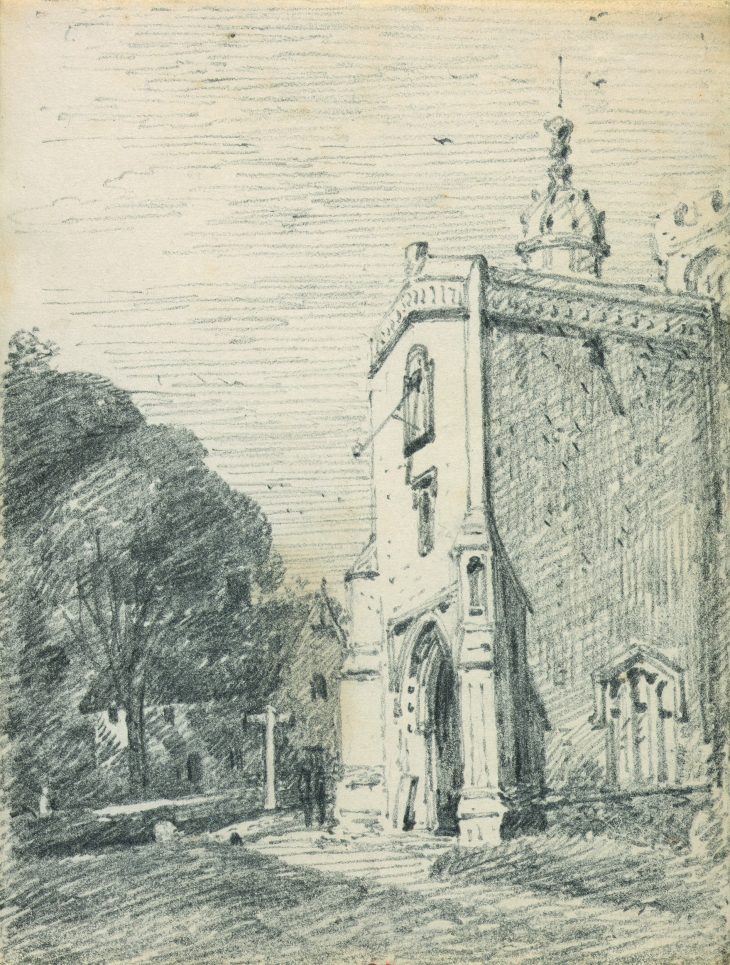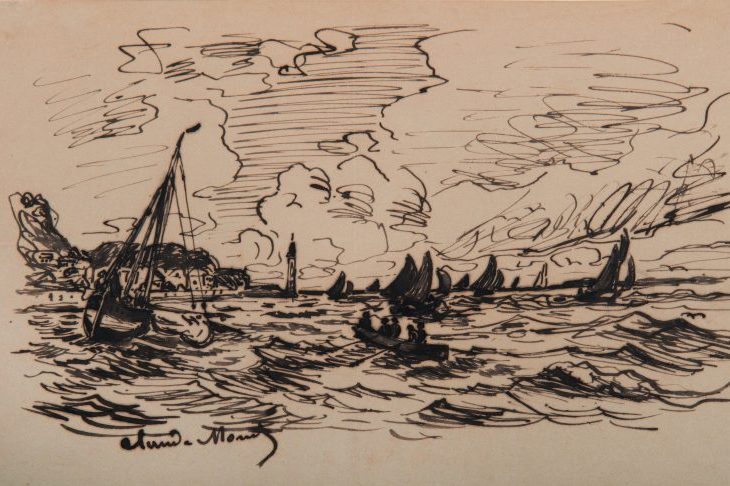For a small art fair, the Salon du Dessin in Paris (21–26 March) certainly punches above its weight. This edition, its 27th, boasts only 39 galleries – events such as Art Basel, Frieze and TEFAF Maastricht host hundreds – in the Palais Brongniart, the highly manageable former stock-exchange building. As ever, though, the fair encourages a city-wide concentration on its niche but deep collecting category.
‘The entire drawings world congregates for the Salon in Paris,’ says British art specialist Lowell Libson, whose gallery is new to the fair. Among the works he is bringing are a group of 10 Constable drawings and two oil sketches on paper made between 1806 and the 1820s, including a pencil drawing, East Bergholt Church: The Porch (1814, €95,000). ‘We’re excited to bring Constable to Paris; it’s the only city where he had real success,’ Libson says. The Salon is also something of a marketing platform for the gallery, which at the beginning of the year announced that director Jonny Yarker was to become a named partner in the business. ‘It’s an opportunity to demonstrate our new branding,’ Libson says.

East Bergholt Church: The Porch (1814), John Constable. Lowell Libson & Jonny Yarker Ltd, €95,000
His gallery is one of five newcomers this year – all of whom hail from outside of France. Three are specialists in modern and contemporary art, including Omer Tiroche Gallery, from London, which brings pieces by artists including Pablo Picasso, Alexander Calder and Jean-Michel Basquiat (booth range €25,000 to €1m). The offerings from New York-based Rosenberg & Co. include an early Henry Moore drawing, Seated Nude (1929, €79,000), which gallery founder Marianne Rosenberg describes as ‘already displaying strong sculp- tural aspects’, and Georges Valmier’s gouache and collage Personnage debout (1920; €30,000), as well as contemporary works by British artist Ann Christopher, among others. The Salon, Rosenberg says, invites ‘a refreshing level of connoisseurship’.
Seated Nude (1929), Henry Moore. Rosenberg & Co., €79,000
At the core of the fair – 19 of the 39 gallerists – are the French old-timers, who also champion the event. Paris dealer Hélène Bailly says she is ‘proud’ to be showing again at the Salon. Works she is bringing include Claude Monet’s Le phare de l’hospice à Honfleur (1865), priced between €200,000 and €300,000 and the only ink drawing known by the artist. Monet drew the work, which is recorded in Daniel Wildenstein’s catalogue raisonné, when he was only 24, to promote the first painting he had accepted to the influential Salon des Beaux-Arts.
As Bailly says, ‘people come from all over the world because drawings are such a particular category’. Their appeal, she says, is that ‘[they] come straight from the heart, from the line, they can’t lie’; Omer Tiroche describes drawings as ‘a personal and intimate vessel for artists’. Paris-based drawings dealer Louis de Bayser, who has been chairman of the fair since 2014, warms to the theme. ‘Officially “dessin” or “drawing” means an original work made on paper, but there’s more to it than that. What collectors are after is the moment of creation, the point when an artist uses paper to begin establishing what comes later.’ He has a prime example of such a work this year: Head of Saint John the Baptist by Cesare da Sesto (c. 1520; price undisclosed). The Lombard artist was a pupil of Leonardo da Vinci and admirer of Raphael. This red chalk on red preparation work, which De Bayser says is still in ‘very good condition’, is a study for the painting Salome (1520), now in Vienna’s Kunsthistorisches Museum. De Bayser is also bringing an intimate pencil study by Odilon Redon of his son (1890s; €80,000) and, on a smaller scale, the red and black chalk Tête de jeune fille by Jean-Antoine Watteau (c. 1716–17, around €200,000; Fig. 4). ‘Watteau is known as a “fête galante” [idealising, poetic] artist, but his drawings are direct, with strong accents,’ says De Bayser.
Tête de jeune fille (c. 1716–17), Jean-Antoine Watteau. Galerie de Bayser, around €200,000
Beyond the fair, several museums and foundations host dedicated exhibitions and private visits as part of what is now known as ‘Drawing Week’. In Paris, the Musée du Louvre’s prints and drawings department has grouped topographical drawings by the little- known Israël Silvestre (1621–91) for ‘France Viewed from the Grand Siècle’ (15 March–25 June); the private Musée de la Chasse et de la Nature offers a tour of its ‘Gérard Garouste: Diana and Actéon’ exhibition (13 March–1 July); and the Pompidou Centre’s print room will show the museum’s drawings for Sergei Diaghilev’s Ballets Russes. Included among the roster of nearly 30 partner institutions are six from outside the capital, including the Musée Condé at Château de Chantilly, north of Paris, where the recently opened Cabinet d’Arts Graphiques is showing Rem- brandt prints from its collection for the first time (until 3 June).
This year, Sotheby’s hosts a coinciding auction on 22 March of nearly 80 Old Master drawings from the collection of Christian and Isabelle Adrien. ‘In France, it’s somehow always been part of being an educated person with taste to have a drawing or two on your walls,’ says Gregory Rubinstein, Sotheby’s worldwide head of Old Master and early British drawings. Works from the collection, mostly by French and Italian artists, span from the 16th century to the early 19th century and include a red chalk male seated nude by the 16th-century Florentine artist Francesco Salviati (estimate €60,000–€80,000) and a relatively large pen-and-ink study of antique domestic objects – a bed and a vase – by Nicolas Poussin (estimate €80,000–€120,000).
Additional events also take place within the fair, including its 13th symposium, this year dedicated to what De Bayser calls ‘the spectacle’ – drawings that relate to the opera, theatre and other performing arts (21–22 March). There will also be a display of 38 drawings of tiaras from the graphic arts collection of jeweller Chaumet, whose clientele included Napoleon’s first wife, Empress Josephine. An expert lecture, courtesy of Olivier Meslay, director of the Clark Art Institute in Williamstown, Massachusetts, will explore the American museum’s drawings collection (21 March); it is particularly strong in 19th-century French drawings, but Meslay promises to delve into some ‘surprising works’, citing the American landscape painter, Winslow Homer.
‘The Salon has its own momentum now’, says De Beyser. ‘It’s established, but we try to inject some little changes every year, to keep people coming.’ So far, so good.
From the March issue of Apollo. Preview and subscribe here.
